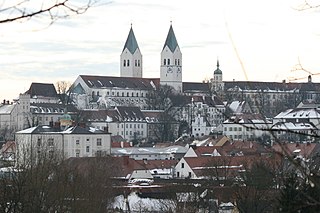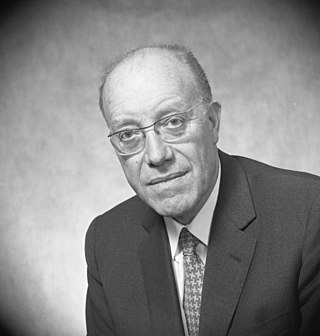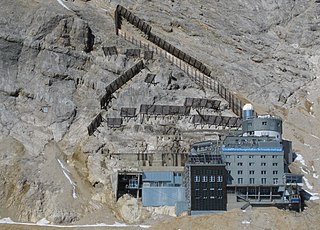
Bavaria, officially the Free State of Bavaria, is a state in the southeast of Germany. With an area of 70,550.19 km2 (27,239.58 sq mi), it is the largest German state by land area, comprising roughly a fifth of the total land area of Germany, and with over 13.08 million inhabitants, it is the second most populous German state, behind only North Rhine-Westphalia; however, due to its large land area, its population density is below the German average. Major cities include Munich, Nuremberg, and Augsburg.

Walter Hans Schottky was a German physicist who played a major early role in developing the theory of electron and ion emission phenomena, invented the screen-grid vacuum tube in 1915 while working at Siemens, co-invented the ribbon microphone and ribbon loudspeaker along with Dr. Erwin Gerlach in 1924 and later made many significant contributions in the areas of semiconductor devices, technical physics and technology.

The Ludwig Maximilian University of Munich is a public research university in Munich, Bavaria, Germany. Originally established as the University of Ingolstadt in 1472 by Duke Ludwig IX of Bavaria-Landshut, it is Germany's sixth-oldest university in continuous operation.

The Technical University of Munich is a public research university in Munich, Bavaria, Germany. It specializes in engineering, technology, medicine, and applied and natural sciences.

Freising is a university town in Bavaria, Germany, and the capital of the Freising Landkreis (district), with a population of about 50,000.

Garching bei München or Garching is a city in Bavaria, near Munich. It is the home of several research institutes and university departments, located at Campus Garching.

Klaus von Klitzing is a German physicist, known for discovery of the integer quantum Hall effect, for which he was awarded the 1985 Nobel Prize in Physics.

The ZKM | Center for Art and Media Karlsruhe, a cultural institution, was founded in 1989 and, since 1997, is located in a former munitions factory in Karlsruhe, Germany. The ZKM organizes special exhibitions and thematic events, conducts research and produces works on the effects of media, digitization, and globalization, and offers public as well as individualized communications and educational programs.
The acronym WSI may refer to:

The Gottfried Wilhelm Leibniz Prize, or Leibniz Prize, is awarded by the German Research Foundation to "exceptional scientists and academics for their outstanding achievements in the field of research". Since 1986, up to ten prizes have been awarded annually to individuals or research groups working at a research institution in Germany or at a German research institution abroad. It is considered the most important research award in Germany.
The University of Bayreuth is a public research university located in Bayreuth, Germany. It is one of the youngest German universities. It is broadly organized into seven undergraduate and graduate faculties, with each faculty defining its own admission standards and academic programs in near autonomy.

Werner Hartmann was a German physicist who introduced microelectronics into East Germany. He studied physics at the Technische Hochschule Berlin and worked at Siemens before joining Fernseh GmbH. At the end of World War II, he and his research staff were flown to the Soviet Union to work on their atomic bomb project; he was assigned to Institute G. In 1955, he arrived in the German Democratic Republic (GDR); in the same year, he founded and became the director of the VEB Vakutronik Dresden, later VEB RFT Meßelektronik Dresden. In 1956, he completed his Habilitation at the Technische Hochschule Dresden and also became a professor for Kernphysikalische Elektronik there. In 1961, he founded the Arbeitsstelle für Molekularelektronik Dresden (AME). He was awarded the National Prize of GDR in 1958. In 1974, he was removed from his positions, significantly demoted, and sent to work as a staff scientist at the VEB Spurenmetalle Freiberg. Hartmann had been the object of security investigations by the Stasi for some time; while he was investigated at length and repeatedly interrogated, the alleged charges were politically motivated and no trial ever took place. The Werner-Hartmann-Preis für Chipdesign is an industrial award given in Hartmann's honor for achievement in the field of semiconductors.

Heinz Maier-Leibnitz was a German physicist. He made contributions to nuclear spectroscopy, coincidence measurement techniques, radioactive tracers for biochemistry and medicine, and neutron optics. He was an influential educator and an advisor to the Federal Republic of Germany on nuclear programs.

The Leibniz-Institut für Kristallzüchtung, German for Leibniz Institute for Crystal Growth and abbreviated with IKZ, is a research institute within the Gottfried Wilhelm Leibniz Scientific Community (WGL) and is a member of the Forschungsverbund Berlin. The institute is based in Berlin, Germany at the WISTA Science and Technology Park in the sub-district of Berlin-Adlershof. Its research activities concentrate on basic research on the fields of natural science and materials science.

The Schneefernerhaus is a former hotel in the Alps, that is now used as an environmental research station. It lies immediately below the summit of the Zugspitze at a height of 2,650 m and was opened on 20 January 1931. It used to house the top station of the Bavarian Zugspitze Railway as well as a tourist hotel. There was then a cable car from the Schneefernerhaus to the Zugspitze summit. In 1938 a gallery for pedestrians was opened from the ridge station of the Tyrolean Zugspitze Cable Car to the Schneefernerhaus. From 1945 to 1952 the hotel was commandeered for use as a "recreation facility" by the US Forces.
Karl Heinz Beckurts was a German physicist and research manager.
Jonathan James Finley is a Professor of Physics at the Technical University of Munich in Garching, Germany, where he holds the Chair of Semiconductor Nanostructures and Quantum Systems. His focus is on quantum phenomena in semiconductor nanostructures, photonic materials, dielectric and metallic films, among others, for applications in quantum technology. At such, he made major contributions to the characterization and understanding of the optical, electronic and spintronic properties of quantum dots and wires both from group-IV and II-VI materials and oxides.

The Campus Garching is a campus of the Technical University of Munich and a number of other research institutes, located around 10 km north of Munich in Garching. At the same time, it constitutes a district of the city. With more than 7,500 employees and around 17,000 students, it is one of the largest centers for science, research and teaching in Germany.
Werner Jacobi was a German physicist and inventor.

The TUM School of Natural Sciences (NAT) is a school of the Technical University of Munich, established in 2022 by the merger of various former departments. As of 2022, it is structured into the Department of Biosciences, the Department of Chemistry, and the Department of Physics. The school is located at the Garching campus.















